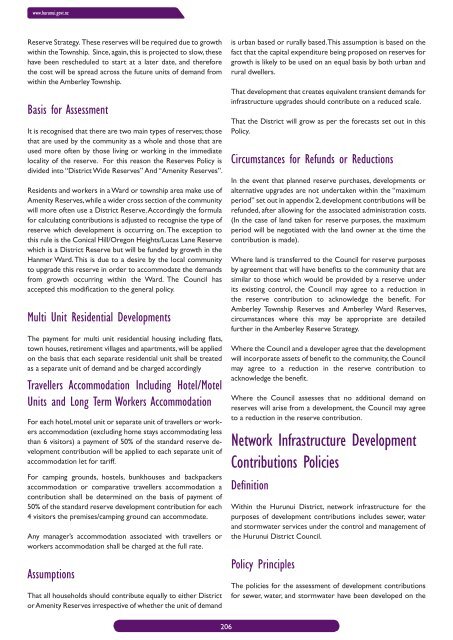Long Term Community Plan 2012-2022 - Hurunui District Council
Long Term Community Plan 2012-2022 - Hurunui District Council
Long Term Community Plan 2012-2022 - Hurunui District Council
Create successful ePaper yourself
Turn your PDF publications into a flip-book with our unique Google optimized e-Paper software.
www.hurunui.govt.nz<br />
Reserve Strategy. These reserves will be required due to growth<br />
within the Township. Since, again, this is projected to slow, these<br />
have been rescheduled to start at a later date, and therefore<br />
the cost will be spread across the future units of demand from<br />
within the Amberley Township.<br />
Basis for Assessment<br />
It is recognised that there are two main types of reserves; those<br />
that are used by the community as a whole and those that are<br />
used more often by those living or working in the immediate<br />
locality of the reserve. For this reason the Reserves Policy is<br />
divided into “<strong>District</strong> Wide Reserves” And “Amenity Reserves”.<br />
Residents and workers in a Ward or township area make use of<br />
Amenity Reserves, while a wider cross section of the community<br />
will more often use a <strong>District</strong> Reserve. Accordingly the formula<br />
for calculating contributions is adjusted to recognise the type of<br />
reserve which development is occurring on. The exception to<br />
this rule is the Conical Hill/Oregon Heights/Lucas Lane Reserve<br />
which is a <strong>District</strong> Reserve but will be funded by growth in the<br />
Hanmer Ward. This is due to a desire by the local community<br />
to upgrade this reserve in order to accommodate the demands<br />
from growth occurring within the Ward. The <strong>Council</strong> has<br />
accepted this modification to the general policy.<br />
Multi Unit Residential Developments<br />
The payment for multi unit residential housing including flats,<br />
town houses, retirement villages and apartments, will be applied<br />
on the basis that each separate residential unit shall be treated<br />
as a separate unit of demand and be charged accordingly<br />
Travellers Accommodation Including Hotel/Motel<br />
Units and <strong>Long</strong> <strong>Term</strong> Workers Accommodation<br />
For each hotel, motel unit or separate unit of travellers or workers<br />
accommodation (excluding home stays accommodating less<br />
than 6 visitors) a payment of 50% of the standard reserve development<br />
contribution will be applied to each separate unit of<br />
accommodation let for tariff.<br />
For camping grounds, hostels, bunkhouses and backpackers<br />
accommodation or comparative travellers accommodation a<br />
contribution shall be determined on the basis of payment of<br />
50% of the standard reserve development contribution for each<br />
4 visitors the premises/camping ground can accommodate.<br />
Any manager’s accommodation associated with travellers or<br />
workers accommodation shall be charged at the full rate.<br />
Assumptions<br />
That all households should contribute equally to either <strong>District</strong><br />
or Amenity Reserves irrespective of whether the unit of demand<br />
is urban based or rurally based. This assumption is based on the<br />
fact that the capital expenditure being proposed on reserves for<br />
growth is likely to be used on an equal basis by both urban and<br />
rural dwellers.<br />
That development that creates equivalent transient demands for<br />
infrastructure upgrades should contribute on a reduced scale.<br />
That the <strong>District</strong> will grow as per the forecasts set out in this<br />
Policy.<br />
Circumstances for Refunds or Reductions<br />
In the event that planned reserve purchases, developments or<br />
alternative upgrades are not undertaken within the “maximum<br />
period” set out in appendix 2, development contributions will be<br />
refunded, after allowing for the associated administration costs.<br />
(In the case of land taken for reserve purposes, the maximum<br />
period will be negotiated with the land owner at the time the<br />
contribution is made).<br />
Where land is transferred to the <strong>Council</strong> for reserve purposes<br />
by agreement that will have benefits to the community that are<br />
similar to those which would be provided by a reserve under<br />
its existing control, the <strong>Council</strong> may agree to a reduction in<br />
the reserve contribution to acknowledge the benefit. For<br />
Amberley Township Reserves and Amberley Ward Reserves,<br />
circumstances where this may be appropriate are detailed<br />
further in the Amberley Reserve Strategy.<br />
Where the <strong>Council</strong> and a developer agree that the development<br />
will incorporate assets of benefit to the community, the <strong>Council</strong><br />
may agree to a reduction in the reserve contribution to<br />
acknowledge the benefit.<br />
Where the <strong>Council</strong> assesses that no additional demand on<br />
reserves will arise from a development, the <strong>Council</strong> may agree<br />
to a reduction in the reserve contribution.<br />
Network Infrastructure Development<br />
Contributions Policies<br />
Definition<br />
Within the <strong>Hurunui</strong> <strong>District</strong>, network infrastructure for the<br />
purposes of development contributions includes sewer, water<br />
and stormwater services under the control and management of<br />
the <strong>Hurunui</strong> <strong>District</strong> <strong>Council</strong>.<br />
Policy Principles<br />
The policies for the assessment of development contributions<br />
for sewer, water, and stormwater have been developed on the<br />
206

















